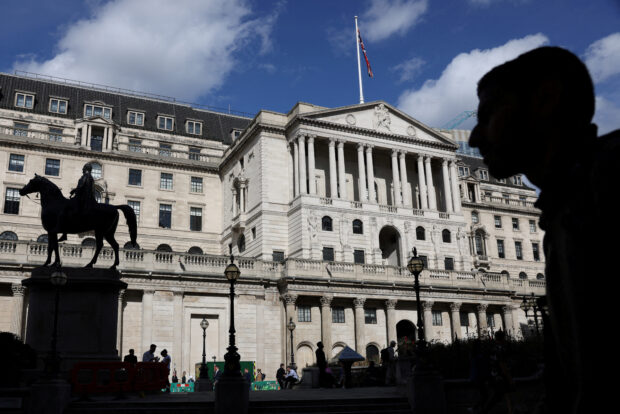
A pedestrian walks past the Bank of England in the City of London, Britain, Sept 25, 2023. REUTERS/Hollie Adams/File photo
LONDON – The Bank of England looks set to stick to its tough line against talk of interest rate cuts in Britain, even as other leading central banks signal that they might be approaching a turning point in their fight against inflation.
The BoE is forecast to keep borrowing costs at a 15-year high on Dec. 14, according to economists in a Reuters poll.
It is also expected to restate that rates must stay elevated to ensure Britain’s still stubborn inflation is beaten.
The European Central Bank and the U.S. Federal Reserve are likely to keep their benchmark borrowing rates on hold next week too. But top officials at both central banks have shown they are now turning their minds to rate cuts.
ECB board member Isabel Schnabel told Reuters this week that the euro zone’s central bank could now take further rate hikes off the table and raised the possibility of a cut in mid-2024.
Last week Christopher Waller, a hawkish and influential voice at the Fed, sounded a similar note of confidence that a first rate cut was on the way.
The BoE is “increasingly looking like a hawkish outlier”, analysts at Natwest Markets said.
Britain’s inflation rate has dropped from a 41-year high of 11.1 percent just over a year ago. But it remains more than double the BoE’s 2 percent target and the highest in the Group of Seven at 4.6 percent in the most recent data for October.
READ: UK inflation rate cools by more than expected
The BoE is worried that strong wage growth has barely slowed despite signs the wider labor market is cooling after its 14 back-to-back interest rate hikes between December 2021 and August this year.
At its last two meetings, it kept Bank Rate at 5.25 percent but said monetary policy is “likely to need to be restrictive for an extended period of time.” It thinks inflation will take two more years to return to 2 percent.
Governor Andrew Bailey has used every opportunity to hammer home his message that it is far too early for the BoE to think about cutting interest rates, a line echoed by most other members of the Monetary Policy Committee.
Chief Economist Huw Pill sent bond prices climbing last month when he said market expectations for a first rate cut in August next year did not seem totally unreasonable, before returning to BoE script in subsequent appearances.
Investors are now pricing a rate BoE rate cut for next May or June after waning inflation pressure around the world prompted a rethink in government bond markets on both sides of the Atlantic.
READ: Bank of England keep rates at 15-year high, rules out quick cuts
But the BoE is seen as being at the back of the pack with markets showing around a 70-percent chance for the ECB and the Fed to cut rates in March.
Most economists polled by Reuters this month expected the BoE to hold out longer, until the July-September period.
Analysts mostly expect the three members of the nine-strong MPC who voted to continue increasing Bank Rate in September and November to do so again given some signs that Britain’s economy is proving resilient to higher borrowing costs.
November’s services and manufacturing purchasing manager index surveys were stronger than investors had expected, consumer confidence has picked up and there have been signs that a slowdown in the housing market has bottomed out.
Furthermore, 20 billion pounds ($25 billion) of tax cuts announced last month by finance minister Jeremy Hunt and a nearly 10 percent jump in the minimum wage are likely to make the BoE determined to keep up its stance that rate cuts are far off.
“While there will be no press conference next week, at which to hammer this message home, we expect the MPC to try to communicate it by keeping a hawkish bias to its guidance,” economists at HSBC said in a note to clients.
($1 = 0.7958 pounds)